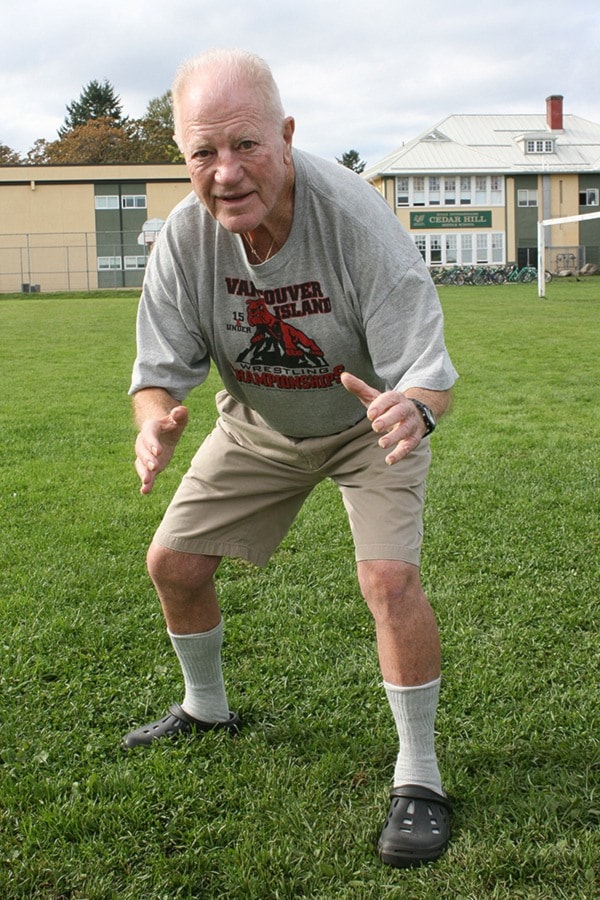Wrestling wasn’t in Ed Ashmore’s blood from the start, but it is now and it will be when he leaves this world.
The local legend has held an open door to the region’s school-aged wrestlers, coaching a district-wide team since 1964. He introduced the sport to athletes who regularly succeeded at provincials and nationals, as well as a few who competed at the Olympics and world championships.
And now at 81 years of age, Ashmore is following some of those names into the Greater Victoria Sports Hall of Fame. He’s entering in the builder category, one of nine to be celebrated at this year’s induction banquet Saturday night at the Westin Bear Mountain Golf Resort.
To this day Ashmore continues to lead the Greater Victoria Commonwealth Bulldogs district wrestling team training sessions, twice a week, in the gymnasium of Saanich’s Cedar Hill middle school. It’s been a lifetime since his dad pushed him into the boxing ring as a three-year-old, the beginning of a long life in athletics.
“I would have been finished with wrestling a long time ago if it wasn’t for Peter [Southwell] and Fraser [Sidaway-Wolf],” Ashmore says.
Arthritis has slowed the otherwise robust octogenarian, who isn’t short on stories.
He can tell you about the rise and fall of Taras Rhyb, the Oak Bay junior high student that represented Canada as an 18-year-old at the 1972 Munich Olympics. Knee problems brought an early end to Rhyb’s wrestling career. Rhyb was inducted to Wrestling Canada’s Hall of Fame in 1988 and the Greater Victoria Sports Hall of Fame in 2002.
Another pupil of Ashmore’s, Kjeld Brodsgaard, entered both the Wrestling Canada Hall of Fame in 2004 and the GVSHOF in 2013 as a builder.
Brodsgaard had followed Ashmore into the world of wrestling officiating and was the head official for the Olympic trials in 1996 and 2000 and chaired the 1994 Commonwealth Games wrestling committee among other leadership roles.
It was Ashmore who led the way, as he had previously earned his FILA international officiating certificate and worked many Canadian and international championships, and was a minor official at the 1976 Olympics. Ashmore twice chaired the organizing committee for the provincial wrestling championships and was the technical assistant for wrestling at the 1994 Commonwealth Games.
At the beginning, however, Ashmore didn’t start in wrestling.
Under his father’s guidance, Ashmore began training in boxing at just three years old. His dad, a Labatt’s brewery employee in London, Ont., was also a fight promoter. It was the late 1930s, and as a lead-up act for a major night of professional wrestling, Ashmore’s father arranged for Ashmore, then three years and eight months old, to box a local five-year-old.
“I didn’t like it, every time I punched him he cried. I knew boxing, I knew how to box,” Ashmore recalls. “It was different in those days.”
As a youth he fought again, however, he eventually moved away from boxing and focused on gymnastics, though not for competition.
He always liked the training of boxing, just not the hitting. That is something that helped him fall in love with wrestling decades later.
But before he made it to Victoria, Ashmore’s family relocated to New Westminster for what became another important step in his development. At 12 years old Ashmore showed up to St. Peter’s School where he met athletics instructor Alex Strain. The latter had an effect on Ashmore that lasts to this day.
“Every one loved [Strain], so many of his kids became teachers.”
Following high school Ashmore worked as an outside stevedore on a merchant ship running up to Alaska and back. At times he had to load 100-pound bags of asbestos.
“Just think about that,” he says.
In 1958 he studied at Victoria College and moved into teaching. He retuned to the college when it because the University of Victoria in 1960 to complete teacher training and started teaching at S.J. Willis junior high, where he stayed for 18 years.
It wasn’t until 1964 that another local fitness legend, Art Burgess, procured Ashmore’s services.
“Art called me down to tour the YMCA and introduced me to the wrestling kids,” says Ashmore, who spoke at Burgess’ memorial service last year.
“A few days later, he called me again, saying ‘I separated my ribs, you need to teach the class.’ I took over the class that week and he didn’t come downstairs to see how I was doing for weeks. That was it.”
Ashmore led hundreds of students at S.J. Willis and then Lansdowne middle school for 16 years after that. His door was always open to students of other schools, and at times he’d have nearly 100 boys running soccer drills or waiting in line to climb the ropes.
He even recalls coaching S.J. Willis’ soccer team, and, if he’s correct, beating Oak Bay when it featured fellow 2015 inductee and Canadian soccer player Ike Mackay.
To this day Ashmore is regularly contacted by former students to meet for coffee and catch up.
“It was always about showing the kids respect, showing them you care about them, and they’ll respect you,” Ashmore says. “They made me taller. How else do you think I managed those kids, I’m only five-foot-six-and-a-half.”
In 2001 the Wrestling Canada Hall of Fame honoured Ashmore with the Outstanding Contributor Award.
